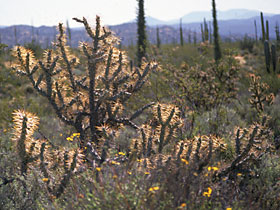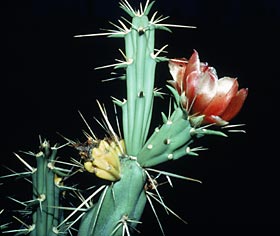![[Ocean Oasis Field Guide]](images/bnr-oo-field.gif)

![[Ocean Oasis Field Guide]](images/bnr-oo-field.gif) |  |
|
Opuntia molesta CACTACEAE (Cactus Family) | |
|
The generic name refers to Opus, an ancient Greek city that was fabled to have "a spiny-type plant growing at the outskirts." DescriptionThis cactus is in the Cylindropuntia group of the genus Opuntia, and is a shrub or tree exhibiting a definite trunk to 0.7-2.5 m (3-7 feet) high. The stems are gray-green (sometimes glaucous) 7-12 cm long and 1-3 cm wide. The spines have orange-brown bases and orange to pale yellow tips in groups of 4-11 and are 34-48 mm long. The flowers are variable in color from yellow, greenish-bronze to dark maroon, 19-26 mm long and showy, blooming April to June. The globose fruit is green to yellow, fleshy 20-40 mm long, spineless or with scattered spines. Range and HabitatThis cholla is endemic to central Baja California, Baja California Sur, and Tortuga Island. Natural HistoryThis cactus grows in desert and coastal sage scrub communities, with two varieties known on the Baja California Peninsula, Opuntia molesta var. clavellina and the more common var. molesta. It is well-adapted for vegetative dispersal since the spines are barbed and the stem segments easily detach. Numerous and dense clonal populations of this cactus have been documented by SDNHM Botany Curator Jon Rebman. This cactus is also a gynodioecious species. |


|
Text by Bob Lauri
Habitat photograph by Jon Rebman, close-up photograph by David Faulkner
Field Guide |
Site Index |
Ocean Oasis Introduction
|
|
© 2000 San Diego Natural History Museum |